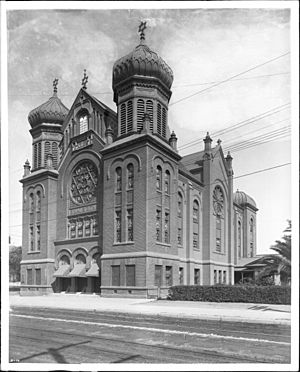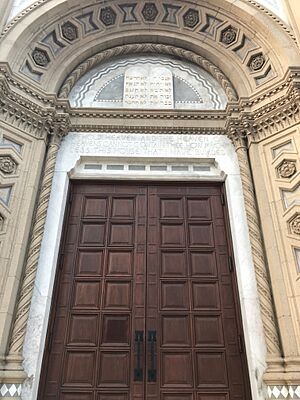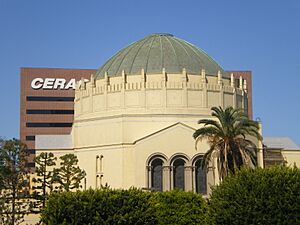Wilshire Boulevard Temple facts for kids
Quick facts for kids Wilshire Boulevard Temple |
|
|---|---|
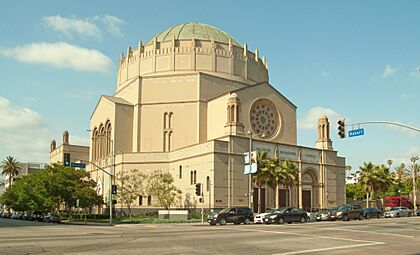
The synagogue building, in 2017
|
|
| Religion | |
| Affiliation | Reform Judaism |
| Ecclesiastical or organisational status | Synagogue |
| Leadership |
|
| Status | Active |
| Notable artworks | Hugo Ballin murals |
| Location | |
| Location | 3663 Wilshire Boulevard, Los Angeles, California |
| Country | United States |
| Architecture | |
| Architect(s) |
|
| Architectural type | Synagogue architecture |
| Architectural style |
|
| Founder | Joseph Newmark |
| General contractor | Herbert M. Baruch Corporation |
| Date established | 1862 (as a congregation) |
| Completed |
|
| Construction cost | $1.5 million |
| Specifications | |
| Capacity |
|
| Dome(s) | One |
| Dome height (outer) | 135 feet (41 m) |
| Dome dia. (outer) | 100 feet (30 m) |
The Wilshire Boulevard Temple is a very old and important Jewish place of worship in Los Angeles, California. It is located on Wilshire Boulevard in the Wilshire Center neighborhood. It started in 1862 and was first called Congregation B'nai B'rith until 1933. It is the oldest Jewish community in Los Angeles.
The main building has a large dome on top and beautiful paintings inside. It was recognized as a historic landmark in Los Angeles in 1973. Later, in 1981, it was added to the National Register of Historic Places. The building was finished in 1929 and designed by architect Abram M. Edelman.
Wilshire Boulevard Temple is one of the biggest Jewish groups in Los Angeles. Many important rabbis have led it. One famous rabbi, Edgar Magnin, served for 69 years, from 1915 to 1984. People called him the "John Wayne" of rabbis.
In 1998, the temple opened a second location on the Westside of Los Angeles. This was because many members had moved to that area. Even though some thought the temple might sell its old building, it decided to fix it up. Big renovations started in 2008, and the main worship area reopened in 2013.
A new building called the Audrey Irmas Pavilion was built next to the synagogue. It is a large, modern space that was finished in 2021. It was designed by a famous architectural firm called the Office of Metropolitan Architecture.
Contents
History of the Temple
Starting Years
The Wilshire Boulevard Temple's story began with the first Jewish worship service in Los Angeles in 1851. In 1862, a small group of Jewish people in Los Angeles officially started Congregation B'nai B'rith. Joseph Newmark led the services at first. Then, Abraham Wolf Edelman became the first rabbi in 1862.
In 1873, the community built its first synagogue. It was a beautiful brick building in the Gothic Revival style in downtown Los Angeles. The Los Angeles Star newspaper called it "the most superior church edifice in Southern California."
By 1885, many members wanted to change from Orthodox traditions. Rabbi Edelman left, and other rabbis came and went. In 1896, the congregation moved to a bigger building at 9th and Hope. This new synagogue was in the Victorian style and had tall towers with large onion domes. It was also designed by Abram M. Edelman.
Sigmund Hecht became rabbi in 1899. In 1903, the congregation joined the Union of American Hebrew Congregations. This was a national group for the Reform Jewish movement. Edgar Magnin became an assistant rabbi in 1915 and the main rabbi in 1919. Both Hecht and Magnin brought in Reform practices. This included using more English in services and adding organ and choir music.
Rabbi Magnin and the New Building
The current Wilshire Boulevard Temple building opened in 1929. It was built near other important places of worship in the Wilshire Center area. Building this new temple was the dream of Rabbi Edgar Magnin. He worked for seven decades and helped shape Jewish life in Los Angeles. He was known as the "Rabbi to the stars."
After World War I, many Hollywood moviemakers became involved with the temple. Rabbi Magnin became the senior rabbi in 1919, and the building project moved forward. Even though many Hollywood producers were not very religious, they liked Rabbi Magnin's idea of a modern Jewish community. Rabbi Magnin also saw that more Jewish people were moving to the west side of the city. The new temple was built to serve this growing community.
The new temple has amazing artwork. The Warner Memorial Murals show stories from the Bible. Hugo Ballin painted these murals. The Warner Brothers (who started the movie studio) paid for them. The murals are 320-foot-long (98 m) and 7-foot-tall (2.1 m). They show important moments in Jewish history. It was unusual for synagogues to have pictures like this. Rabbi Magnin was inspired by old European cathedrals and new discoveries of ancient synagogues with art.
The huge dome of the temple looks like the Pantheon in Rome. It is 100 feet (30 m) wide, and its top is 135 feet (41 m) above the street. Irving Thalberg, a movie studio head, paid for the dome's inside decorations. A special prayer is written in Hebrew around the top of the dome. It says: "Hear, O Israel, the Lord our God, the Lord is One."
The temple also has beautiful rose windows and stained glass windows. They were designed in the Gothic style by Oliver Smith Studios. These windows are considered some of the best in the United States. During a recent renovation, the rose window was fixed. It shows a Torah Scroll and a Star of David. The other windows have thousands of pieces of glass and represent the 12 tribes of Israel. Film producer Louis B. Mayer paid for these windows.
The temple's large dome quickly became a famous landmark in Los Angeles. The big marble columns inside look impressive, but they are actually hollow plaster painted to look like marble. Unlike many synagogues, this temple does not have a center aisle. This was done to make it feel as open as a movie theater.
The Herbert M. Baruch Corporation finished building the temple. It cost $1.5 million in 1929. The temple was officially opened in June 1929 with a three-day celebration led by Rabbi Magnin.
The congregation changed its name to Wilshire Boulevard Temple in 1933. Rabbi Magnin led the temple until he passed away in 1984. He was a very important voice in the community. In 1980, the street block where the temple is located was named Edgar F. Magnin Square. In 1984, the temple building was added to the National Register of Historic Places because of its special design and history.
New Leadership and Campuses
After Rabbi Magnin's death, Harvey Fields became the senior rabbi in 1985. He led the congregation for 18 years. He brought back some older traditions. He also added more music, and the temple hired its first trained cantor (a singer who leads prayers).
Rabbi Fields helped create groups like the Interfaith Coalition to Heal L.A. and "Hands Across L.A." These groups brought different faiths together to help after the 1992 Los Angeles riots.
As more members moved to the Westside of Los Angeles, the temple built a second campus. It opened in 1998 as the Audrey and Sydney Irmas Campus. This new campus has a Jewish day school and other learning and community spaces. Even though there were rumors the temple would leave its historic building, Rabbi Fields promised to keep the original location.
Over the years, many important people have visited the temple. The Dalai Lama spoke there in 1999.
Restoring the Main Building
In 2000, the J. Paul Getty Trust gave a grant to the temple to help preserve its historic building. This was part of an effort to protect Los Angeles' cultural heritage.
Rabbi Fields retired in 2003. Steven Leder, who had worked at the temple since 1987, became the new senior rabbi. In 2004, the temple celebrated the 75th birthday of its historic building. The area around the temple had changed a lot, becoming part of the Koreatown district. Many Jewish people had moved to the Westside. The temple had to decide whether to sell the old building.
Instead, the congregation decided to keep its landmark building and help the surrounding community. They also noticed that younger Jewish people were moving to neighborhoods further east. So, they started a big project to restore the main worship area and redevelop the city block around it. The renovations began in 2008 under Rabbi Steven Z. Leder. The temple worked with architect Brenda Levin to create a big plan. This plan included fixing the synagogue, building a new pre-school and elementary school, a social service center, and sports facilities. A film called Restoring Tomorrow shows the renovation process.
The main auditorium was closed for two years for renovations after the 2011 High Holy Days.
In 2013, a generous person named Erika Glazer promised $30 million for the ongoing restoration. The Wilshire Center facility is now called the Erika J. Glazer Family Campus. The main worship area reopened in September 2013 for Rosh Hashanah services. The temple plans to offer community services for everyone in the area, including non-Jewish residents. Local leaders have praised this effort, hoping it will be a model for other groups.
In 2013, Judson Studios restored the temple's neo-Gothic windows. Artist Lita Albuquerque designed a memorial wall, and artist Jenny Holzer created special benches.
Audrey Irmas Pavilion
| Audrey Irmas Pavilion | |
|---|---|
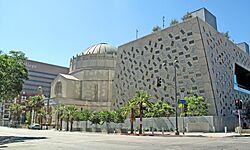
The Audrey Irmas Pavilion located adjacent to the synagogue in 2022
|
|
| General information | |
| Architectural style | Deconstructivism (attrib.) |
| Address | 3643 Wilshire Boulevard, Los Angeles, California 90010 |
| Coordinates | 34°03′42″N 118°18′16″W / 34.0618008°N 118.3045415°W |
| Completed | 2022 |
| Cost | $95 million |
| Technical details | |
| Floor count | Three |
| Floor area | 55,000 square feet (5,100 m2) |
| Design and construction | |
| Architect | Shohei Shigematsu |
| Architecture firm | Office for Metropolitan Architecture |
In 2015, a committee of temple members looked at many architectural firms for the Audrey Irmas Pavilion. They chose a design by Shohei Shigematsu from the Office for Metropolitan Architecture's New York office. The plan was for a five-story building with a rooftop garden, offices, and a large banquet hall. It would replace a parking lot next to the main temple building.
The temple received a $30 million promise from Audrey Irmas. This came after she sold a painting. Wallis Annenberg also gave $15 million to finish the pavilion. She also gave $3 million for a special 7,000-square-foot cultural space (650 m2) on the third floor for older adults, called GenSpace.
The pavilion cost $95 million and was finished in 2022. Its outside walls have 1,230 hexagonal panels. Each panel and window is set at a unique angle. The ground floor has a 14,000-square-foot event space (1,300 m2) with a polished red concrete floor. The second floor has a chapel and an outdoor terrace. On the third floor, Mia Lehrer designed a circular sunken garden.
The building was made to host religious and cultural events. It has three different gathering spaces: a Grand Ballroom, a smaller Chapel, and a sunken garden.
Rabbinical Leaders
Here are the senior rabbis who have led Congregation B'nai B'rith:
| Ordinal | Officeholder | Term Start | Term End | Time in Office |
|---|---|---|---|---|
| 1 | Abram Wolf Edelman | 1862 | 1885 | 22–23 years |
| 2 | Ephraim Schreiber | 1885 | 1889 | 3–4 years |
| 3 | Abraham Blum | 1889 | 1895 | 5–6 years |
| 4 | Moses G. Solomon | 1895 | 1899 | 3–4 years |
| 5 | Sigmund Hecht | 1899 | 1919 | 19–20 years |
| 6 | Edgar F. Magnin | 1919 | 1984 | 64–65 years |
| 7 | Alfred Wolf | 1984 | 1985 | 0–1 years |
| 8 | Harvey J. Fields | 1985 | 2003 | 17–18 years |
| 9 | Steve Leder | 2003 | 2025 | 21–22 years |
| 10 | Joel Nickerson | 2025 |
Notable Members
Many interesting people have been members of the Wilshire Boulevard Temple, including:
- Lawrence Bender
- Lowell Ganz
- Jami Gertz
- Maurice Kremer
- Tony Ressler
- Robert B. Sherman
- Fred Sands
- Daniel Steres (born 1990), a professional soccer player
- Jack L. Warner
- Bud Yorkin
See Also



